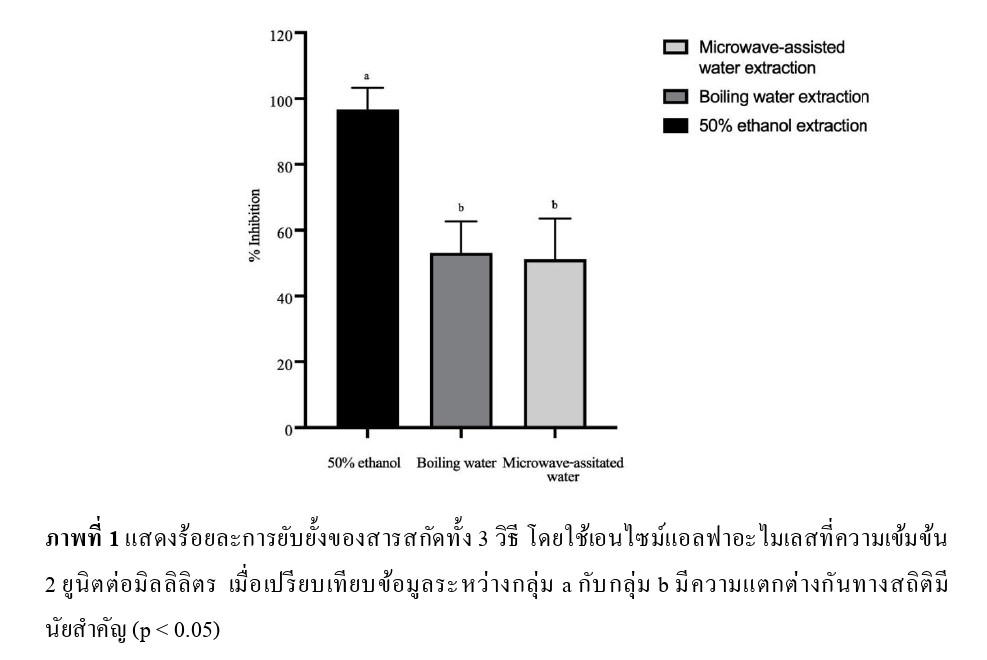Inhibitory Effects of Stink Bean (Parkia speciose) Extracts Against α-amylase and α-Glucosidase Activity
Keywords:
α-amylase, α-glucosidase, Parkia speciosa (Sator) extract, enzyme inhibitionAbstract
Sator (Parkia speciosa Hassk) is the favorite plant in the 3 southern border provinces of Thailand. The sator extracts indicated the presence of antioxidants, antimicrobials and inhibition of cancer cells. However, the previous study of inhibition of α-amylase and α-glucosidase activity has not been reported. Both enzymes play an importance role of decreasing blood glucose levels resulting in amelioration of non-communication chronic diseases (NCDs). Therefore, this study focused on 4 distinct extraction methods. The results showed that the 50% ethanol extraction is the most ability to inhibit the α-amylase at 96.65 ± 6.58 % and IC50 at 0.42 mg/ml. The fifty percentage of ethanol extraction is a better inhibitor than acarbose for the α-amylase (p < 0.05). To investigate the preference of the α-glucosidase from intestinal rat inhibition, these extracts had less α-glucosidase inhibitory activity. The result of α-glucosidase from Saccharomyces cerevisiae was found to be most inhibition by 100 % ethanol extraction of 27.67 ± 2.38 % at the enzyme concentration of 0.25 mg/ml compared with the acarbose significantly (p < 0.05). The sator extracts have been able to inhibit both α-amylase and α-glucosidase activity. The data from this study can be used as supporting knowledge for further research in supplemental food and complementary medicine including prevention of NCDs.
References
Azliza, M.A., Ong, H.C., Vikineswary, S., Noorlidah, A., & Haron, N.W. (2012). Ethno- Medicinal Resources Used by the Temuan in Ulu Kuang Village. Ethno Medicine, 6(1), 17 - 22. http://doi.org/10.1080/09735070.2012.11886415
Chalopagorn, P., & Klomsakul, P. (2017). α–Amylase and α–Glucosidase Inhibitory Activities of Ceasalpinia sappan, Ficus foveolata and Eurycoma longifolia Extracts. Phranakhon Rajabhat Research Journal (Science and Technology), 12(1), 63 – 73. https://li01.tci-thaijo.org/index. php/PRRJ_Scitech/article/view/67254
Connolly, A., Piggott, C.O., & FitzGerald, R.J. (2014). In Vitro α-Glucosidase, Angiotensin Converting Enzyme and Dipeptidyl Peptidase-IV Inhibitory Properties of Brewers' spent Grain Protein Hydrolysates. Food Research International, 56, 100 - 107. https://doi.org/10. 1016/j.foodres.2013.12.021
Kamisah, Y., Othman, F., Qodriyah, H.M.S., & Jaarin, K. (2013). Parkia speciosa Hassk.: A Potential Phytomedicine. Evid Based Complement Alternat Med, 709028. https://doi.org/10.1155/ 2013/709028
Karnjanapiboonwong, A. (2020). Situation of non-communicable diseases according to Thailand's 9 global goals. In Karnjanapiboonwong, A., Khamwangsanga, P., & Kaewtha, S. (Eds.), Report on the NCDs disease situation diabetes, high blood pressure and related risk factors 2019 (pp. 15-31). PARBPIM Ltd.
Laya, A., Koubala, B.B., & Negi, P.S. (2022). Antidiabetic (α-Amylase and α-Glucosidase) and Anti-Obesity (Lipase) Inhibitory Activities of Edible Cassava (Manihot esculenta Crantz) as Measured by In Vitro Gastrointestinal Digestion: Effects of Phenolics and Harvested Time. International Journal of Food Properties, 25, 492 - 508. https://doi.org/10.1080/10942912. 2022.2050256
Luyen, N.T., Tram, L.H., Hanh, T.T.H., Binh, P.T., Dang, N.H., Minh, C.V., & Dat, N.T. (2013). Inhibitors of α-Glucosidase, α-Amylase and Lipase from Chrysanthemum morifolium. Phytochemistry Letters, 6(3), 322 - 325. https://doi.org/10.1016/j.phytol.2013.03.015
Manoon, S. (1988). Sator. Agricultural base Printing.
Narathiwat Provincial Statistical Office. (2023). Narathiwat Provincial Statistical. Author
Pantong, W., Somsap, O., Kamnate, A., Ekchaweng, K., Obchoei, S., & Saeheng, S. (2024). Analyzing the Antibacterial, Anticancer, and Antioxidant Qualities of the Stink Bean (Parkia speciose) by Various Extraction Techniques. Trends in Sciences, 21(9), 7994. https://doi.org/ 10.48048/tis.2024.7994
Rozaq, P., & Sofriani, N. (2009). Organic Pesticide from Urine and Spices Modification. Asian Journal of Food and Agro-Industry, Special Issue, 105 -111. https://typeset.io/papers/organic-pesticide-from-urine-and-spices-modification-5bn4igqh1x
Samuel, A.J.S.J, Kalusalingam, A., Chellappan, D.K., Gopinath, R., Radhamani, S., Husain, H.A., & Promwichit, P. (2010). Ethnomedical Survey of Plants Used by the Orang Asli in Kampung Bawong, Perak, West Malaysia. Journal of Ethnobiology and Ethnomedicine, 6, 1 - 5. https://doi.org/10.1186/1746-4269-6-5
Sangchan, A. (2018). Inhibitory Effect of Thai Vegetable Extracts on Activity of Lipase, Alpha-Amylase, Trypsin and Alcohol Dehydrogenase [Master’s Thesis]. Burapha University. https://digital_collect.lib.buu.ac.th/dcms/files/56910052.pdf
Sungkhachart, K. (2019) Area-based and people-centered management of non- communication chronic disease. PARBPIM Ltd.
Tunsaringkarn, T., Rungsiyothin, A., & Ruangrungsi, N. (2008). α-Glucosidase Inhibitory Activity of Thai Mimosaceous Plant Extracts. Journal of Health Research, 22(1), 29 – 33. https://he01.tci-thaijo.org/index.php/jhealthres/article/view/155555
Tunsaringkarn, T., Rungsiyothin, A., & Ruangrungsi, N. (2009). α-Glucosidase Inhibitory Activity of Water-Soluble Extract from Thai Mimosaceous Plants. The Public Health Journal of Burapha University, 4(2), 54 - 63. https://he02.tci-thaijo.org/index.php/phjbuu/article/view/ 45607

Downloads
Published
How to Cite
Issue
Section
License
Copyright (c) 2024 Princess of Naradhiwas University Journal

This work is licensed under a Creative Commons Attribution-NonCommercial-NoDerivatives 4.0 International License.



